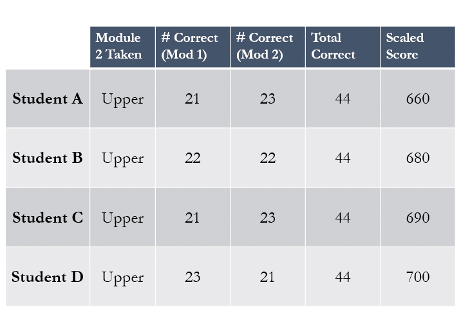The Newly Adaptive, Modular Structure of the Digital PSAT and SAT
The PSAT and SAT have gone digital. While the switch to a digital format is getting the most press, the real headline should be the tests’ newly adaptive, modular structure. This is the change that will have the biggest impact on students, both in their test-taking experience and, most importantly, in how their scores will be calculated.
Although the digital SAT won’t be implemented until March 2024, students have already started taking the digital PSAT, making it important to understand exactly how your students’ PSAT scores are being calculated before scores are released in November (though exact score release dates will depend on when your school tested). The PSAT/NMSQT is also important as the qualifying exam to determine National Merit Scholarships, though we are still waiting to find out how this new digital, adaptive PSAT/NMSQT will impact the National Merit score cutoffs.
The digital SAT will continue to be scored on a 1600-point scale. However, PSAT scores (as they have in the past) max out at 1520 because the PSAT serves as a simplified, preparatory version of the SAT, featuring slightly easier passages and less trigonometry and complex math.
It’s important to sit with that fact for a bit. A perfect PSAT score of 1520 does not guarantee students will get a perfect score of 1600 on the SAT, as there will be more difficult content on the SAT. Similarly, a lower PSAT score does not mean students won’t achieve an extremely high score on the SAT—that is, so long as you help your students interpret their PSAT score reports as intended: as indicators of their current mastery of skills and as a guide to help them prepare for the SAT.
Special grace should also be extended to this year’s students who may have been caught off-guard by the digital and adaptive test-taking experience and the content changes that have been made to the PSAT. Reports of technology failures have also been widespread, which means your students may have had a particularly stressful PSAT testing experience. Fortunately, a student’s PSAT results still offer an enormous opportunity to gain insight into the skills they need to focus on before the SAT.
Understanding Your Students’ Digital PSAT Scores
The digital PSAT’s total score is made up of two subsection scores: 1) the Reading and Writing section score and 2) the Math section score. Each of these can range from 160-760.
Here is where the new adaptive scoring of the digital PSAT (and SAT) comes into play. Each section (Reading and Writing; Math) is separated into two sequential modules. Every student will see the same first module, while the difficulty level and content of the second module will be determined by how well a student performs on the first.

What does this mean for students? The harsh reality is that if a student does not receive the harder Module 2, their score will be capped at a lower maximum compared with that of students who do. However, it’s not as straightforward as simply working to get certain number of questions correct to “unlock” the harder second module.
Because the test is adaptive on a module level, it means that individual questions are weighed differently when scored. Essentially, difficult questions will be “worth more” than easier questions. This means that even if two students get the exact same number of questions right, they can receive dramatically different scores depending on which questions they get right.
To illustrate, the table below shows official score results gathered from four actual students on the Reading and Writing section (graded on a scale of 160-760). All four students received the harder (upper) second module and all answered the same total number of questions correctly (44). Despite this, each obtained a completely different score.

Even more noteworthy is that students A and C correctly answered the exact same number of questions in each module and yet have a 30-point difference in their final section score!
The Harsh Realities of Adaptive Scoring on the Digital SAT and PSAT
The bottom line is that it’s no longer enough for students to solely focus on getting as many questions right as possible. Since College Board is not releasing information on individual question difficulty, it’s currently impossible to accurately identify which specific questions and topics they are weighing more heavily than others and draw any conclusions beyond the basic insight that harder questions are likely worth more.
That means students will need to chew gum and walk at the same time: focus on getting as many questions correct as possible AND focus on getting the most difficult questions correct. This significantly impacts the way students should be preparing for the digital SAT once they receive their PSAT score reports.
In the past, students could earn points efficiently by prioritizing mastery of the most common examples of certain skills. For example, when learning semicolons, students could focus on the most basic usage rules (like joining independent clauses) while saving time by omitting more complex and obscure usages (like separating clauses in a list) that are rarely tested. Dauntingly, they’ll now need to master both to receive the harder second module and maximize their scores.
For these reasons, it’s more important than ever to make sure your students have the necessary support. Contact Academic Approach today.

